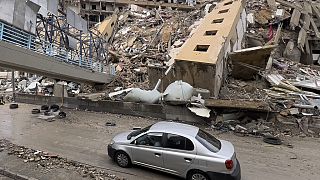biodiversity
It's hard to believe that a river flowed through this land in Kenya's Machakos County.
It's just over a hundred miles from the capital Nairobi with its demands as a growing city.
Construction, the need to make glass, cement, concrete and a host of everyday items is what leads the workers and their lorries here.
But the constant excavation of sand n is threatening the environment.
These teams of sand excavators say they are aware of the problem, but there is no system to help them manage the harvesting sustainably.
John Mutisya collects and sells sand in Kenya.
He says he and others have seen the devastation caused by uncontrolled sand harvesting.
"For our sand, sometimes we excavate to the detriment of our grazing areas, leading to our animals lacking water, but if the government can construct sand catchments so that we can have watering and grazing areas, put regulations where we are supposed to pass while carrying sand and restrict others and construct good roads, it will be a good move," says Mutisya.
"The sand carried from these rivers in a day is in hundreds and thousands of tons because an average semi-trailer can carry 50 tons, (but) there are those for 30 tons and one like mine which is 15 tons. So in a day, it's hard to know the exact (amount) but it's thousands of tons," he adds.
Halinish Yusuf is the Sand Conservation and Utilization Director at Makueni County.
She believes there is a clear need to regulate the industry and to carry out studies to discover whether the resources they have in terms of sand can meet the growing demands.
"Because of the strategic importance of sand being the second most extracted natural resource after water and the importance because of the modernization that is going on, demand from the construction industry, demand from the glass industry and many other industries, there is a need to start thinking about regulating it, recycling, regulating where its harvested, how its harvested, but also thinking about alternatives and also thinking about upscaling and monitoring how its harvested, where, the amounts we have so that we start planning for the future," says Yusuf.
In Kiambu County, a new construction site requires more building materials.
The groundbreaking ceremony to mark a new housing project is cause for celebration, but it could have detrimental consequences for the environment from which the sand is being excavated.
Many rivers in this part of Kenya are bare, and only huge protruding rocks remain.
Lorries excavating sand runs on almost a 24-hour cycle to supply building sites like this one in Kiambu.
Site engineer Samuel Waweru of Vimika Construction has to turn this 20-acre site into a block of residential apartments in the next 18 months.
He argues the regulation of sand supply is a government issue, but he says his crews will also be able to use the rocks to make the necessary building materials.
"About the river sand we don't have data on how much sand is being used but it is in huge figures in terms of millions of tons. In the future because of the environment, we have seen some counties prohibit sand harvesting but in case of sand is prohibited, we have an alternative where we can use rock sand. Rock sand we get it from the ballast, when we are crushing the ballast the byproduct is rock sand which is recommended to use as a substitute for river sand," he says.
According to a recent report by the United Nations Environment Programe (UNEP) sand is the second-largest exploited resource after water.
It says globally, 50 billion tons of sand and gravel are harvested every year.
The conservation group WWF says: "sand mining is already putting unprecedented pressure on rivers, floodplains and deltas," leading to erosion, biodiversity loss and reduced protection from storm surges.
Many communities in Kenya depend on this sort of excavation as their only source of income and as a consequence in some regions, uncontrolled harvesting has led to environmental damage which has been largely overlooked.
According to Yusuf, there needs to be an inventory to understand how much sand is left, what damage has been done and what the demands of the industry will be in the coming years.
She says: "Unfortunately, there is no data to show how much sand is going to be demanded in future development, and by the same token there is hardly any research on the amount of sand deposits that we have. And so, there is, even as we make plans, development plans as governments, we are not able to tell how much sand will be required and if we are running into a crisis or not and so, there is a need to invest in research, to know how much sand deposits we have, how much can be harvested, and how much is needed for development."
Mutisya is aware that his livelihood is already going to have an impact on the supply of water to his family because as the sand disappears and the ground heads underground water supplies are depleted.
He says: "We are saying if the government puts in structures, we will be ready to comply with those restrictions because in doing so we will conserve water for our livestock and even for our own consumption, so that there is a restricted area so that we can conserve the water because we are headed to a very dry season where we will be forced to buy water, even for our livestock."












01:44
IUCN report says one in three of world's trees in danger of extinction
01:10
COP16: Indigenous Colombians support ‘Biodiversity Action Plan’ to 2030
01:33
Delegates meet in Colombia to address global biodiversity crisis
01:31
Seven-story block collapses in northern Nairobi, tenants of adjacent buildings evacuated
01:41
Kenya relocates 50 elephants to larger park to ease overcrowding
02:35
Senegal: Raising awareness among the youth to preserve coastal environments